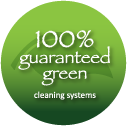Avoid chemicals in conventional oven cleaners
Many conventional oven cleaners seem to miraculously dissolve even the toughest baked-on messes after just a few minutes. There’s a good reason for that: they’re usually made with extremely corrosive ingredients. According to the U.S. Environmental Protection Agency, oven cleaners typically contain lye (either sodium hydroxide or potassium hydroxide.)
Lye may be effective, but it’s also dangerous. It can burn your eyes and skin, and can be fatal if swallowed, so it’s not a safe product to have in your home, especially if you have young children.
Prevent oven messes that are tough to clean
The first step to a clean oven is prevention. Try placing casserole dishes on cookie sheets while baking to keep sauces from spilling over onto oven surfaces. You could also line the bottom of your oven with aluminum foil if you’re cooking a dish that’s likely to make a mess. Wipe up any minor spills immediately to keep them from hardening into a mess that’s tougher to clean.
How to clean an oven naturally
It’s easy to make non-toxic oven cleaners yourself with basic ingredients like baking soda, lemon juice and vinegar. These natural oven cleaning solutions are frugal, effective and totally free of harmful chemicals and caustic ingredients.
For grease, mix non-toxic dish soap like Seventh Generation Free & Clear Natural Dish Liquid with water and scrub with a sponge. Natural dish soaps contain cleaners derived from plant sources like coconuts to dissolve fats.
To tackle bad smells, squeeze two lemons into a baking dish filled with an inch of water and toss in what remains of the lemons. Place the dish in the oven and bake it for 30 minutes at 250 degrees. Not only will your oven smell like lemons instead of scorched food, the citrus oils will soften gunk on oven surfaces, making it easier to remove.
Burnt-on food and elbow grease
For burnt-on food, sprinkle baking soda over the bottom of the oven and then spritz it with water from a spray bottle. Let it sit overnight and then remove it in the morning with a sponge, and most of the gunk in the oven will come out with it. If baked-on spills still remain, sprinkle on some more baking soda and then add a little bit of white vinegar. Let the bubbling mixture sit for 30 minutes, then scrub.
To remove the cloudy residue that has made a glass oven window nearly opaque, try mixing baking soda and lemon juice into a thick paste. Rub it onto the door, leave it for half an hour and then scrub, and the glass will be clear and shiny again.
Finally, for those situations where elbow grease just doesn’t seem to cut it, don’t be afraid to use the self-cleaning function on your oven if you have one. Self-cleaning ovens heat up to temperatures that can reach 900 degrees Fahrenheit to burn off spilled food. While this process uses a lot of energy, it’s offset by the fact that self-cleaning ovens are double-insulated, reducing your overall energy consumption from regular use. Just try not to use it more than once a year or so.




